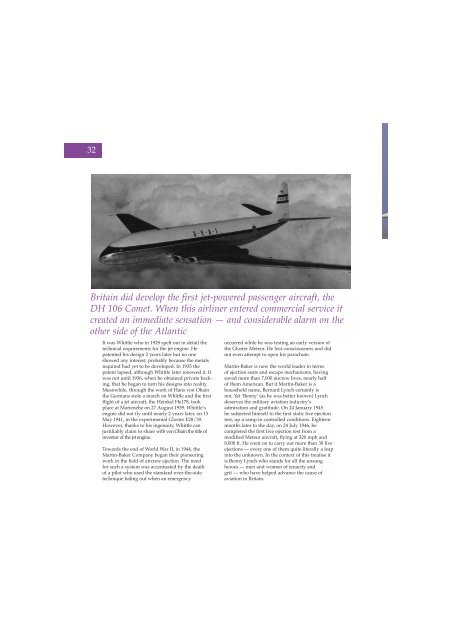Volume 6 No 4 - Royal Air Force Centre for Air Power Studies
Volume 6 No 4 - Royal Air Force Centre for Air Power Studies
Volume 6 No 4 - Royal Air Force Centre for Air Power Studies
You also want an ePaper? Increase the reach of your titles
YUMPU automatically turns print PDFs into web optimized ePapers that Google loves.
32<br />
Britain did develop the first jet-powered passenger aircraft, the<br />
DH 106 Comet. When this airliner entered commercial service it<br />
created an immediate sensation — and considerable alarm on the<br />
other side of the Atlantic<br />
It was Whittle who in 1928 spelt out in detail the<br />
technical requirements <strong>for</strong> the jet engine. He<br />
patented his design 2 years later but no one<br />
showed any interest, probably because the metals<br />
required had yet to be developed. In 1935 the<br />
patent lapsed, although Whittle later renewed it. It<br />
was not until 1936, when he obtained private backing,<br />
that he began to turn his designs into reality.<br />
Meanwhile, through the work of Hans von Ohain<br />
the Germans stole a march on Whittle and the first<br />
flight of a jet aircraft, the Heinkel He178, took<br />
place at Marienehe on 27 August 1939. Whittle’s<br />
engine did not fly until nearly 2 years later, on 15<br />
May 1941, in the experimental Gloster E28/39.<br />
However, thanks to his ingenuity, Whittle can<br />
justifiably claim to share with von Ohain the title of<br />
inventor of the jet engine.<br />
Towards the end of World War II, in 1944, the<br />
Martin-Baker Company began their pioneering<br />
work in the field of aircrew ejection. The need<br />
<strong>for</strong> such a system was accentuated by the death<br />
of a pilot who used the standard over-the-side<br />
technique baling out when an emergency<br />
occurred while he was testing an early version of<br />
the Gloster Meteor. He lost consciousness and did<br />
not even attempt to open his parachute.<br />
Martin-Baker is now the world leader in terms<br />
of ejection seats and escape mechanisms, having<br />
saved more than 7,000 aircrew lives, nearly half<br />
of them American. But if Martin-Baker is a<br />
household name, Bernard Lynch certainly is<br />
not. Yet ‘Benny’ (as he was better known) Lynch<br />
deserves the military aviation industry’s<br />
admiration and gratitude. On 24 January 1945<br />
he subjected himself to the first static live ejection<br />
test, up a ramp in controlled conditions. Eighteen<br />
months later to the day, on 24 July 1946, he<br />
completed the first live ejection test from a<br />
modified Meteor aircraft, flying at 320 mph and<br />
8,000 ft. He went on to carry out more than 30 live<br />
ejections — every one of them quite literally a leap<br />
into the unknown. In the context of this treatise it<br />
is Benny Lynch who stands <strong>for</strong> all the unsung<br />
heroes — men and women of tenacity and<br />
grit — who have helped advance the cause of<br />
aviation in Britain.
















